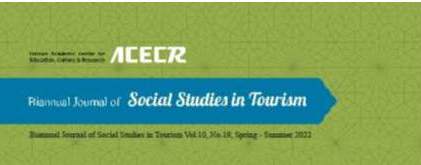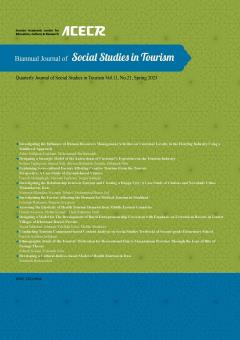-
-
List of Articles
-
Open Access Article
1 - Investigating the Influence of Human Resources Management Activities on Customer Loyalty in the Hoteling Industry Using a Multilevel Approach
zahra Nikkhah-Farkhani Mohammad shaykhzade -
Open Access Article
2 - Designing a Strategic Model of the Antecedents of Customer’s Experience in the Tourism Industry
soghra taghipour Samad Aali Alireza Bafandeh Zendeh Hakimeh Niki -
Open Access Article
3 - Explaining Socio-cultural Factors Affecting Creative Tourism From the Tourists’ Perspective: A Case Study of Zayandehrood Visitors
Faezeh Mohaghegh masoud taghvaei Negin sadeghy -
Open Access Article
4 - Investigating the Relationship between Tourism and Creating a Happy City: A Case Study of Chalous and Nowshahr Cities, Mazandaran, Iran
nastaran khandan nazanin Tabrizi mohammad hasan zaal -
Open Access Article
5 - Investigating the Factors Affecting the Demand for Medical Tourism in Mashhad
Fatemeh Rahmani pejman avazpoor -
Open Access Article
6 - Assessing the Elasticity of Health Tourism Demand from Middle Eastern Countries
hamid asayesh mahdi kamali hadi rahmani fazli -
Open Access Article
7 - Designing a Model for The Development of Rural Entrepreneurship Ecosystem with Emphasis on Ecotourism Resorts in Tourist Villages of Khorasan Razavi Province
Javad Sakhdari Jahangir Yadolahi farsi Malihe Shahriary -
Open Access Article
8 - Conducting Tourism Component-based Content Analysis on Social Studies Textbooks of Second-grade Elementary School
Faezeh Asadian Ardakani -
Open Access Article
9 - Ethnographic Study of the Tourists' Motivation for Recreational Trip to Mazandaran Province Through the Lens of Rite of Passage Theory
Zohreh Korani Fatemeh Sam -
Open Access Article
10 - Developing a Cultural-Indices-based Model of Health Tourism in Iran
samaneh barkhordari
-
The rights to this website are owned by the Raimag Press Management System.
Copyright © 2017-2025







